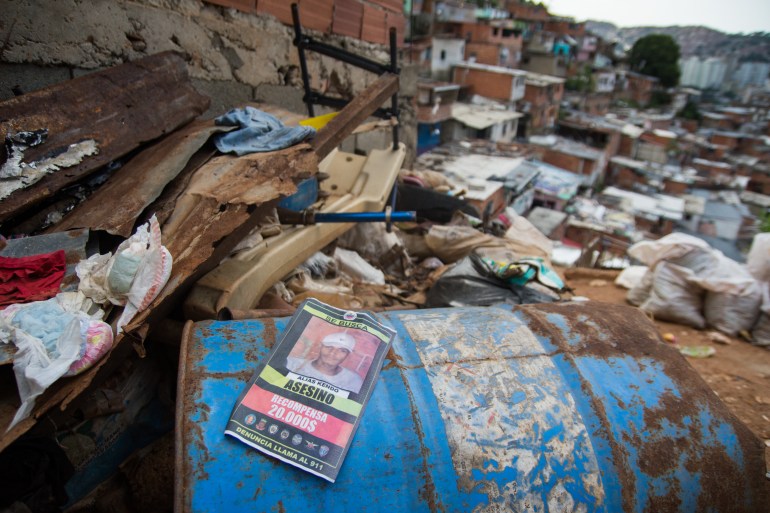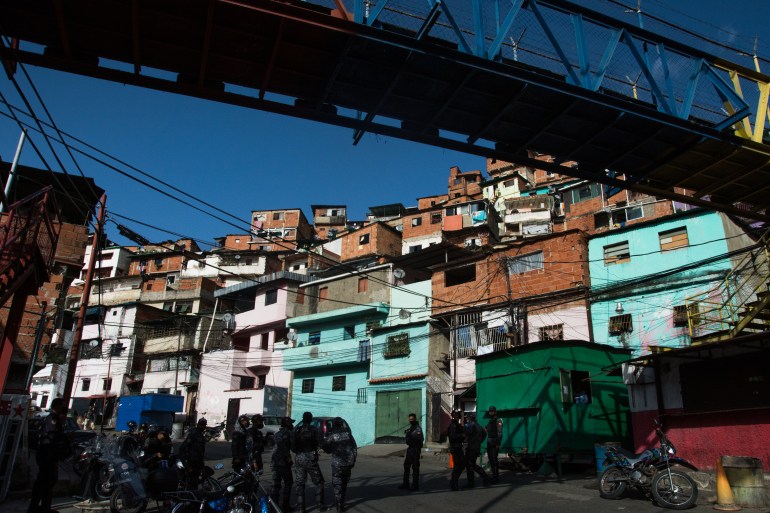Caught between gangs and Venezuelan police in Cota 905
Residents describe the battle for control in one of Caracas’ most violent neighbourhoods.

Caracas, Venezuela – The 300,000 residents of the Cota 905 shantytown perched on the hills of western Caracas are no strangers to violence.
Their neighbourhood, abandoned by police in 2017, has been run by gangs. There had been a few clashes in recent months, but nothing like the all-out fighting that drove Ines (not her real name – she like others in this piece asked for anonymity for fear of retaliation) to flee her home in the middle of a gunfight.
Keep reading
list of 3 itemsVenezuela arrests opposition politician for terrorism, treason
UK government backs Guaido in Venezuela gold dispute
Ines and 11 other families lived in an abandoned preschool. As police descended on Cota 905 on July 7, gang members told Ines and her neighbours that they could either leave or hide, that they were going to use the school as a firing point. The fighting had already been raging for 12 hours.
Cota 905 had long been under control of a gang, run by Carlos Luis Revete, known as El Koki. A 2017 deal with the government had named it a “Peace Zone”, meaning the police abandoned it, leaving residents to police themselves. President Nicolas Maduro’s government hoped the strategy would help lower violence; instead, Revete used the time to consolidate his hold on power, better arm his fighters, and expand into other neighbourhoods.

Fearful of both the gangs and the police, Ines and her 16-year-old daughter took what clothes and food they could and left the school. They walked several hours before taking refuge at a relative’s home.
The next day, a neighbour who stayed behind called her with bad news. “The police broke my door; they ransacked my house,” she told Al Jazeera.
Neighbours said they saw the police leaving the preschool with their belongings, including a refrigerator and a washing machine. The Venezuelan information ministry which speaks for the police did not respond to a request for comment.
The fighting was still ongoing. Explosions could be heard in nearby middle-class neighbourhoods. Stray bullets were a concern. A woman was wounded in front of one of Caracas’ main markets, Quinta Crespo, and the nearby Southern Cemetery was also considered dangerous.
More than 3,100 officers from different forces were sent to Cota 905 and other areas affected by the fighting, according to the country’s minister of interior, justice and peace, Carmen Melendez.
“The State Security Organizations continue to be deployed in the areas violated by these criminals and will not rest until they recover absolute control,” she tweeted July 8th.

The following day, more people had left. Entire families were walking around Caracas in the rain, carrying small bags, looking for somewhere to stay until the violence stopped. Residents told Al Jazeera they worried the police would involve them or their children in the conflict – imprisoning or killing them then falsely labelling them gang members.
Ines said that had become common during police raids: “If they can’t find the guilty, they look among the innocent and young ones,” she told Al Jazeera. “I’ve lost family members during these raids already.”
A helicopter flew over Cota 905 on the fourth day of fighting, dropping hundreds of flyers with the faces of the leaders and other alleged gang members, offering more than $1.5m in rewards for their capture – $500,000 for leaders, $20,000 for members.
One of the flyers caught Alejandra’s attention. “My son was killed four years ago and now the police are offering $20,000 for him,” she told Al Jazeera. She said her son, Kenderson, was sleeping inside her house when police officers dragged him outside and shot him in front of his family’s home.
She said he was one of many victims of what the government had called the “Operation Liberation and Protection of the People”, a group of mixed military-police interventions between July 2015 and June 2017 purportedly targeting criminal gangs. Maduro had called it “the perfect instrument for peace”. According to the UN, the operations resulted in arbitrary arrests and at least 413 extrajudicial executions.

“They are just ridiculing my pain,” Alejandra said, holding a flyer with her deceased son’s face printed on it. She said Kenderson was a hard-working man and was never involved in gang activity. Alejandra said she was scared the police could come back and wanted people to know her son is already dead.
Ines’ sister, Amelia, stayed in Cota 905 through more than four days of fighting before she left. She sent her eldest son, 21, to a location she would not disclose. Ines thought having three sons in one place could be dangerous. She took her other two sons to Cartanal, 76 km (47 miles) away – far enough, she thought, to be safe.
After she had deposited her children at a relative’s house, she went back to Cota 905 to retrieve food left behind because they fled in a rush. She said she could not afford to buy more.
While Ines was gone, police came into the house where her niece and two younger sons were playing a video game. They pointed guns at them – then blindfolded them. They kept asking about “a suitcase full of money”, Ines’ youngest son said – she did not want his name or that of her niece published.

The officers ordered her niece and youngest son to “walk away and don’t look back” while her middle son, Yoeiker, 19, was held to be questioned. Soon after they left the house, her niece and youngest son said they heard two gunshots.
Neighbours said that the police had been walking around Cartanal in Los Valles del Tuy, asking if there were any people from Cota 905 in the area.
Yoeiker thought he had a way out of the shantytown. He had been offered a position on a professional basketball team and was scheduled to join them in the upcoming season, Ines said. His family described him as a timid young man, whose only passion was sports.
During Yoeiker’s burial, his aunt looked on while gravediggers put cement on top of his grave, to prevent looting. “They’re sealing a young man’s life, a promise of basketball and the dream of a mother. All of it just for being from Cota 905.”
Al Jazeera changed the names of interviewees at their request for fear of retribution.